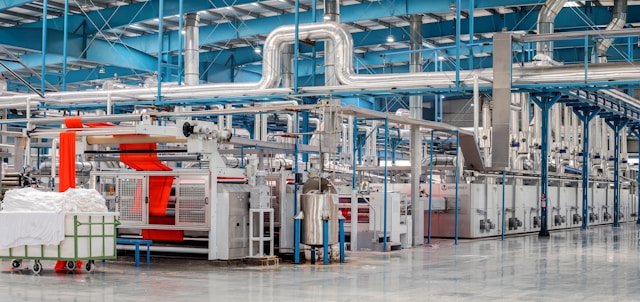When it comes to manufacturing, noise is just a part of the job; it’s just to be expected, right? Well, technically, yes, yes, it is. But at the same time, noisy work areas can be a productivity killer, too. It’s not just that, but this can impact worker safety too. Even in the manufacturing business, sometimes the noise levels need to be put down a few notches. But how exactly can you do that? What’s the best way to go about this even? Well, here’s exactly what you need to know!
Start Off with a Sound Plan
Before diving into purchasing expensive equipment or remodeling your space, it’s essential to understand where and how noise is generated in your facility. Alright, so that’s pretty much expected, right? Large machines make noise; it’s just what they do. Well, with that said, you’ll also want to try to conduct a noise audit using sound level meters to pinpoint particularly loud areas and identify the sources of excessive noise.
This step is crucial because it helps you apply the right solutions more effectively and economically. Also, sometimes, some machinery isn’t meant to make as much noise as it is. It depends on what it is, of course, but it’s something to think about, too.
Maintain Your Machinery
Often, the most straightforward solutions are the most overlooked. Just like what was already said above, sometimes it’s the machinery itself that’s too loud when it’s not actually meant to be that loud. So this is exactly why you want to have regular maintenance of your machines. This can significantly reduce noise levels.
But you might also want to see if you can add some compression springs to help with the noise levels and check for loose parts, poor lubrication, or misalignment—these can usually cause machines to operate with more noise than necessary. So again, be sure to have an established routine maintenance schedule to ensure machines are not only running smoothly but quietly.
Upgrade to Quieter Equipment
So, this is going to massively depend on your manufacturing plant, but older machines are known for being loud. For the most part, you can usually find a quieter upgrade for most machinery. It’s not just about that; newer models are usually more energy efficient, too.
While it might not be ideal to have to deal with upfront costs, this can still be safer and probably even cheaper in the end. Just think of it like this: it’s an investment that pays off by improving the working conditions and the health of your workforce.
Use Sound-Dampening Material
Simple modifications can make a big difference- sometimes a massive difference. So, with that said, it might be a really good idea to look into installing sound-absorbing panels around noisy machines or using anti-vibration mounts, which can dampen noise significantly.
Materials such as foam, rubber, or specially designed acoustic panels can be used to line walls and ceilings, absorbing sound before it travels across the facility. Again, this can be costly (granted, not too expensive), but this can massively help make the workspace safer.
Rethink Your Facility Layout
Sometimes, the arrangement of machinery can contribute to noise levels. This one actually surprises a lot of people, but it is true. So, it might be a good idea to consider placing high-noise equipment in areas less frequented by workers or using barriers between noisy and quiet zones. Think about the workflow and whether rearranging the floor plan could naturally reduce noise exposure for your team.
Consider Implementing Enclosures
Just think of a room for a moment. You close the door, and you hear less of the noise, right? So, it’s basically that you may want to try. Enclosures block noise and this can be fairly affordable, too. These enclosures don’t have to be elaborate to be effective.
Simple structures that surround a noise source can prevent sound from dispersing widely. You just have to ensure these enclosures have proper ventilation to avoid overheating and consider this solution for equipment that doesn’t need frequent operator intervention.
Provide PPEs
There are a lot of regulations, so the chances might have already been high that you were already doing this, but in this case, it’s still best to address this. While this doesn’t lower noise levels per se, ensuring that your workforce is equipped with effective hearing protection is crucial. There are regulations in place, and organizations are already having to push this, so just make sure there are some strict guidelines put in place so that earplugs or earmuffs are worn in loud areas.
This is so important (and again, regulations for this), as these can protect employees from the harmful effects of prolonged exposure to noise, especially in areas where engineering solutions are insufficient.
Foster a Culture of Awareness
Can this actually help? Well, to a degree, this can be pretty effective! Educating your team about the risks of noise pollution and the importance of noise reduction measures can cultivate a more mindful workplace. Usually, it’s not their fault; it’s the machinery, but it still helps address your staff and your team. You might even want to encourage workers to report high noise levels and suggest improvements. Sometimes, the best ideas come from those who are on the floor every day.
Look into Policy and Procedure Modifications
Sometimes, operational policies can contribute to unnecessary noise—for example, the simultaneous use of high-noise machinery. It might be a good idea to modify procedures to stagger the use of such equipment or implement ‘quiet hours’ where certain operations are restricted to manage overall noise exposure.
Rethink the Routine
So it’s not just the layout that you may want to rethink, but you might also want to rethink the routine too. Sometimes, it’s not about adding new things but shifting how you use what you’ve got. So, this means examining your operational routines might reveal opportunities to reduce noise—like not running all your loudest machines at once or setting up ‘quiet hours’ during shifts.
